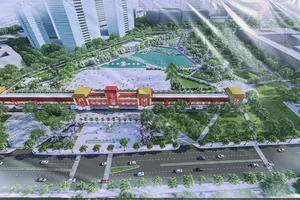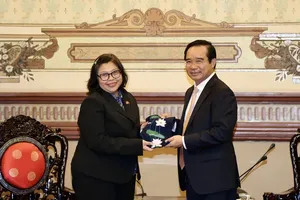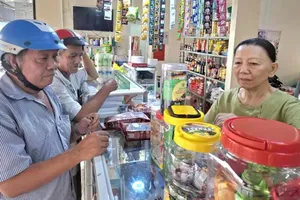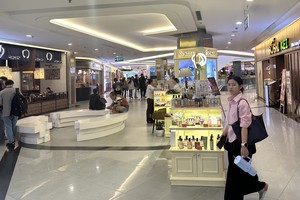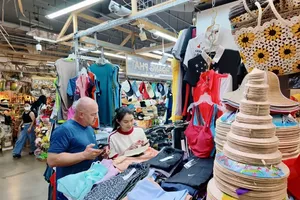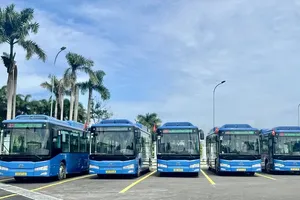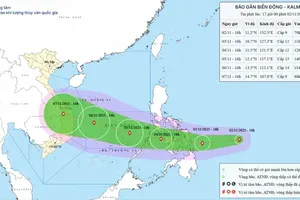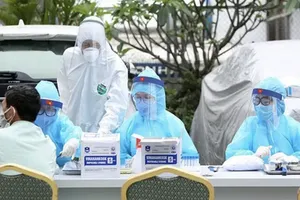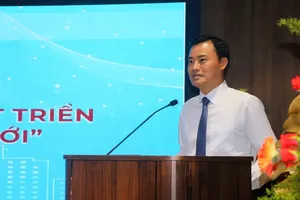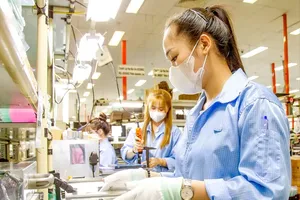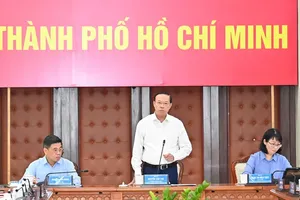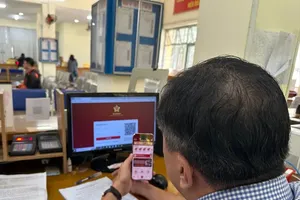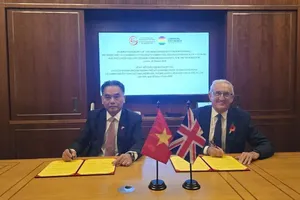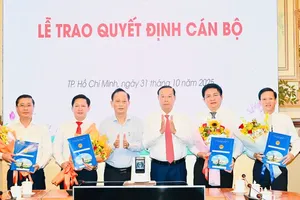
Cultural bridges
In the late afternoon, inside the quiet courtyard of Ong Bon Pagoda (Cho Lon Ward), Mr. Nguyen patiently guides visitors making incense offerings. “I don’t really know all the official meanings of the ceremonies,” he explains with a gentle smile. “I just know that Nguyen Tieu (the Lantern Festival) has, for a very long time, been a great, joyful day, not just for us – Chinese people – but for our Vietnamese, Cham, and Khmer neighbors, too. Anyone with a good heart is welcome. We all come to light incense, admire the lanterns, and watch the lion dances and classical opera.”
In Nguyen’s memory, Nguyen Tieu in Cho Lon area is a bit like a second Tet holiday for the Chinese people. It’s a bustling period starting from the 15th day of the first lunar month, replete with customs, rituals, and even the strictness of old traditions. People come to pray for peace for themselves, for their children’s health, and for family prosperity. These are, at the end of the day, universal wishes shared by all.
Nguyen Tieu has reportedly long since transcended the borders of a single community; it’s become a major cultural event for all of HCMC. In Cho Lon, on the 15th day of the first lunar month, streets are “ablaze with lanterns.” Processions of lion and dragon dancers snake through the streets, their drums mixing with the laughter of the crowds. It’s a scene that connects generations, “whether they are Kinh or Chinese, whatever their religion, whatever their ethnicity.”
According to the HCMC Major Events Organizing Committee, the festival attracts tens of thousands of residents and tourists. The street art parade alone involves 1,200-1,500 performers, with thousands more lining the roads. The combination of ancient rituals, calligraphy, lantern exhibits, classical opera, and concerts not only revives old customs but also transforms them into a unique cultural product for a dynamic city.
The Chinese in HCMC may call it the “second Tet,” but in this city, Nguyen Tieu is also a day of reunion, sharing, and integration. Each red lantern lit doesn’t just illuminate Cho Lon; it illuminates “the unity of a multi-colored city.”
And it’s not just Nguyen Tieu. HCMC’s identity is also built from the customs of its other communities. For the city’s Khmer, Chol Chnam Thmay (New Year) brings the pagodas to life, filling entire neighborhoods with the sound of drums and music.
The Cham community in Phu Nhuan still preserves the sacred rites of the Kate festival, where the sounds of the Paranung drum and Saranai flute echo in a modern space, serving as a reminder of their roots.
The Kinh community, meanwhile, gathers for the Nghinh Ong Festival in Can Gio. It’s a time for fishermen to pray for calm seas and favorable weather, but it’s also a cherished occasion to reconnect and share after a long year at sea. Each festival, each custom, carries its own unique hue, but they all share a common purpose: to nurture identity and bind the community.
Religious festivals: Symphony of unity
The bells of Binh Thai Parish church ring out on a Sunday morning. A steady stream of people passes through the gates as another service begins. The parish atmosphere is buzzing, filled with an extra layer of anticipation that comes with the final months of the year. Christmas is still almost two months away, and yet, at a few small cafes surrounding the church, the trees are already up, sparkling with red ornaments as if to herald the season’s arrival.
For 41-year-old Nguyen Thi Lien, this is a weekly ritual. She brings her son to church early, finds a seat in the middle, and occasionally leans over to remind him, “Read slowly, follow the Pastor.” In her small notebook, tucked next to a to-do list – pay rent, buy notebooks for her son, do a charity food run – she jots down a new line: “Register for Christmas delivery logistics.”
In HCMC, Christmas has clearly broken the bounds of a purely religious rite. Every December 24, dazzling lights blanket the central streets as tens of thousands of residents and tourists pour onto the streets, soaking in the festive air.
City leadership delegations also reportedly make their annual visits to congratulate Catholic and Protestant organizations, sending a powerful message of peace and unity. The holiday, in short, has become a symbol of affection, a season of sharing that radiates from the parish, to the family, and out to the entire city community.
That spirit doesn’t just end when the tinsel comes down. It continues year-round. In the fourth lunar month, Buddhists flock to pagodas for Phat Dan (Buddha’s Birthday celebration), piously bathing the Buddha statue, lighting incense for peace, and expressing their compassion through free vegetarian meals, charity medical trips, and heartfelt gifts.
During Ramadan, the Cham Muslim community observes their daylight fast, then gathers at sunset for the simple but warm Iftar meal, a ritual that both preserves ancient traditions and tightens their community bonds.
It’s precisely this richness that has created a HCMC that is at once modern and deeply humane – a place where religious faith not only uplifts spiritual life but actively helps to build and nurture the great bloc of national unity.
Unique festivals and customs of HCMC’s ethnic and religious communities
- Cho Lon Lantern Festival (Nguyen Tieu, 15th day of 1st lunar month): Dazzling lantern streets, lion and dragon dances, a gathering point for the Chinese, Vietnamese, Cham, and Khmer communities.
- Buddha’s Birthday (Phat Dan, 4th lunar month): Thousands of Buddhists attend ceremonies, bathe the Buddha, join flower float parades, and organize vegetarian meals and charity events, spreading a spirit of compassion.
- Christmas (Dec 25): City streets sparkle with lights. It has transcended religious rites to become a city-wide season of reunion and sharing.
- Ramadan (Cham Muslim community): A holy month of fasting, with communal Iftar meals that tighten family bonds and preserve ancient rituals in a modern city.
- Chol Chnam Thmay (Khmer community, April): Pagodas come alive with music, dancing, and Buddha-bathing ceremonies, reflecting Khmer identity in the heart of the city.
- Nghinh Ong Festival (Can Gio, 8th lunar month): Fishermen pray for favorable weather and pay tribute to “Lord Whale.” It is the largest sea festival in Southern Vietnam.
- Cao Dai Grand Peace Ceremony: Held periodically at the Tay Ninh Holy See and HCMC temples, sending a message of harmony and union.


